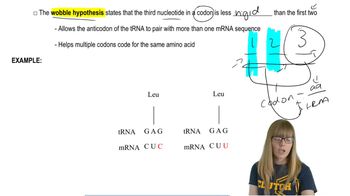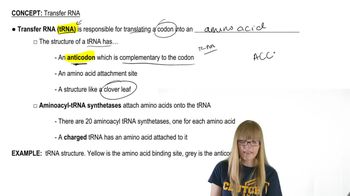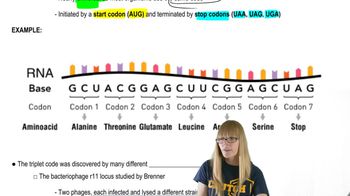Table of contents
- 1. Introduction to Genetics51m
- 2. Mendel's Laws of Inheritance3h 37m
- 3. Extensions to Mendelian Inheritance2h 41m
- 4. Genetic Mapping and Linkage2h 28m
- 5. Genetics of Bacteria and Viruses1h 21m
- 6. Chromosomal Variation1h 48m
- 7. DNA and Chromosome Structure56m
- 8. DNA Replication1h 10m
- 9. Mitosis and Meiosis1h 34m
- 10. Transcription1h 0m
- 11. Translation58m
- 12. Gene Regulation in Prokaryotes1h 19m
- 13. Gene Regulation in Eukaryotes44m
- 14. Genetic Control of Development44m
- 15. Genomes and Genomics1h 50m
- 16. Transposable Elements47m
- 17. Mutation, Repair, and Recombination1h 6m
- 18. Molecular Genetic Tools19m
- 19. Cancer Genetics29m
- 20. Quantitative Genetics1h 26m
- 21. Population Genetics50m
- 22. Evolutionary Genetics29m
11. Translation
The Genetic Code
Problem 13a
Textbook Question
Third-base wobble allows some tRNAs to recognize more than one mRNA codon. Based on this chapter's discussion of wobble, what is the minimal number of tRNA molecules necessary to recognize the following amino acids?
lysine
 Verified step by step guidance
Verified step by step guidance1
Understand the concept of wobble: The wobble hypothesis explains how a single tRNA can recognize multiple codons for the same amino acid. This is due to the flexibility in base pairing at the third position of the codon.
Identify the codons for lysine: Lysine is encoded by two codons, AAA and AAG.
Determine the anticodons: The anticodons that pair with AAA and AAG are UUU and UUC, respectively.
Apply the wobble rules: According to the wobble hypothesis, the third position of the anticodon can pair with more than one base. In this case, U at the first position of the anticodon can pair with both A and G at the third position of the codon.
Conclude the minimal number of tRNAs: Since one tRNA with the anticodon UUU can recognize both AAA and AAG due to wobble, only one tRNA is necessary to recognize lysine.
Recommended similar problem, with video answer:
 Verified Solution
Verified SolutionThis video solution was recommended by our tutors as helpful for the problem above
Video duration:
2mPlay a video:
Was this helpful?
Key Concepts
Here are the essential concepts you must grasp in order to answer the question correctly.
Wobble Hypothesis
The wobble hypothesis explains how the third base of a codon can pair loosely with the corresponding tRNA anticodon, allowing a single tRNA to recognize multiple codons. This flexibility reduces the number of tRNA molecules required for protein synthesis, as one tRNA can accommodate variations in the third position of codons that code for the same amino acid.
Recommended video:
Guided course

Translation:Wobble Hypothesis
tRNA and Codons
Transfer RNA (tRNA) molecules are responsible for bringing amino acids to the ribosome during protein synthesis. Each tRNA has an anticodon that pairs with a specific mRNA codon, which is a sequence of three nucleotides that codes for a particular amino acid. Understanding the relationship between tRNA and codons is essential for determining how many tRNAs are needed for a given set of amino acids.
Recommended video:
Amino Acids and Their Codons
Amino acids are the building blocks of proteins, and each amino acid is encoded by one or more codons in the genetic code. For lysine, there are two codons (AAA and AAG) that specify this amino acid. Recognizing the codons associated with lysine is crucial for determining the minimal number of tRNA molecules required to translate the corresponding mRNA.
Recommended video:

 11:43m
11:43mWatch next
Master The Genetic Code with a bite sized video explanation from Kylia Goodner
Start learningRelated Videos
Related Practice



